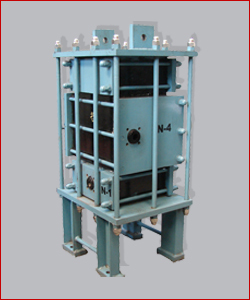Introduction
Orange Graphite Heat Exchanger is a specialized heat exchanger designed for handling highly corrosive fluids, particularly in industries dealing with strong acids, alkalis, and other aggressive chemicals. The term “orange” likely refers to a protective coating or casing applied to the heat exchanger, which enhances its durability, chemical resistance, and environmental protection. Graphite-based heat exchangers are widely used due to their non-metallic nature, making them highly resistant to corrosion compared to traditional metal heat exchangers like stainless steel, titanium, or copper-based units. These heat exchangers are essential in industries where metallic corrosion is a major concern, such as chemical processing, pharmaceuticals, fertilizers, wastewater treatment, and acid production plants. Their high thermal conductivity, excellent chemical resistance, and ability to operate in extreme conditions make them a preferred choice for applications involving hydrochloric acid, sulfuric acid, nitric acid, and phosphoric acid.
Key Features of an Orange Graphite Heat Exchanger
Graphite Material for Corrosion Resistance
Graphite is a non-metallic material that provides exceptional resistance to corrosive chemicals, including strong acids and bases. Unlike metals that can corrode, graphite remains chemically stable even in highly acidic or oxidizing environments. This makes it ideal for industries requiring continuous exposure to aggressive fluids.
High Thermal Conductivity
One of the most significant advantages of a graphite heat exchanger is its excellent thermal conductivity, which ensures efficient heat transfer. Graphite has a thermal conductivity that is comparable to certain metals, making it highly efficient for applications requiring precise temperature control.
Protective Orange Coating
The orange color of these heat exchangers is typically due to an epoxy, rubber, or polymer-based coating, which serves multiple purposes:
- Additional corrosion protection for external surfaces
- Mechanical reinforcement to enhance durability
- Resistance to environmental conditions, such as humidity and chemical exposure
This coating further extends the lifespan of the heat exchanger, ensuring long-term performance with minimal maintenance.
Versatile Design Options
Graphite heat exchangers come in various configurations to suit different applications:
- Shell and Tube Graphite Heat Exchanger – Used for high-pressure applications where durability is crucial.
- Block Type Graphite Heat Exchanger – Designed for compact installations with efficient heat transfer properties.
- Plate Type Graphite Heat Exchanger – Offers a lightweight, modular design for flexibility in installation and maintenance.
Resistance to Thermal Shock
Unlike metals, graphite exhibits high resistance to sudden temperature changes, making it highly effective in process industries with fluctuating temperatures. This property prevents cracking or structural failure, which is common in metal-based heat exchangers under extreme thermal cycling.
Suitable for High-Purity Applications
Graphite heat exchangers are widely used in industries where contamination must be avoided, such as:
- Pharmaceutical production
- Food and beverage processing
- Semiconductor manufacturing
The non-reactive nature of graphite ensures that no metallic contamination occurs in the heat exchange process.
Low Maintenance and Long Service Life
Graphite heat exchangers require minimal maintenance since they do not suffer from scaling, rust, or internal corrosion like metal-based units. This significantly reduces downtime and operational costs, making them a cost-effective long-term solution.
Advantages of Using an Orange Graphite Heat Exchanger
- Superior Corrosion Resistance – Can handle the most aggressive chemical environments.
- High Thermal Efficiency – Provides excellent heat transfer while maintaining low energy consumption.
- Longer Service Life – Outlasts traditional metal heat exchangers in corrosive applications.
- Low Maintenance Costs – Requires minimal cleaning and servicing due to its non-scaling and non-corrosive properties.
- Lightweight and Compact – Easier to install and transport compared to metallic heat exchangers.
- Environmentally Friendly – Reduces the need for chemical inhibitors used in metal heat exchanger maintenance.
Conclusion
Orange Graphite Heat Exchanger is an advanced thermal management solution specifically designed for handling highly corrosive fluids in industrial applications. Its graphite-based construction ensures exceptional chemical resistance, making it ideal for industries dealing with strong acids, alkalis, and other aggressive substances. The orange protective coating adds an extra layer of durability, making it even more reliable and long-lasting in extreme working conditions. With its high thermal conductivity, low maintenance requirements, and superior corrosion resistance, a graphite heat exchanger is a cost-effective, efficient, and sustainable choice for industries that require safe and reliable heat transfer solutions. As industrial demands for corrosion-resistant equipment continue to grow, these heat exchangers will play a vital role in enhancing process efficiency, reducing operational costs, and ensuring long-term performance.

